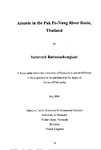Arsenic in the Pak Pa-Nang River Basin, Thailand
| dc.contributor.author | Rattanachongkiat, Saravuth | |
| dc.contributor.other | Faculty of Science and Engineering | en_US |
| dc.date.accessioned | 2013-11-14T12:00:25Z | |
| dc.date.available | 2013-11-14T12:00:25Z | |
| dc.date.issued | 2004 | |
| dc.identifier | NOT AVAILABLE | en_US |
| dc.identifier.uri | http://hdl.handle.net/10026.1/2710 | |
| dc.description.abstract |
The Pak Pa-Nang River Basin is located in southern Thailand. Its environmental degradation has been arising because its catchment is mineralized with substantial deposits of tin forming part of the SE Asian Tin Belt, with the presence of arsenopyrite gives rise to high arsenic concentrations, mobilized during past mining activity. Suitable techniques have been developed, for the extraction of arsenic species in a variety of environmental and biological samples. Trypsin and cellulase enzymatic extraction procedures were used to extract arsenic species from fish and plant samples, respectively. Arsenic species in sediments were determined following 1 M H3P04 extraction in an open focused microwave system. An anion-exchange HPLC system employing a step elution, with sulphate and phosphate solution as the mobile phase coupled with ICP-MS was used for separation and detection of the important arsenic species, e.g. AsB, DMA, MMA, and inorganic arsenic in fish and plant samples. And species of AsIII, AsV, MMA and DMA were determined in sediment samples. A nitric acid microwave digestion procedure, followed by carrier gas nitrogen addition (N2)-ICP-MS analysis, to overcome argon chloride (40Ar35Cl+) interference, was used to measure total arsenic. Validation for these procedures was carried out using certified reference materials and real samples, mussel, cockle, green seaweed, brown seaweed and sediment collected from the Tamar Estuary, UK. Fish samples from the Pak Pa-Nang Estuary showed a range for total arsenic concentration, up to 17 µg gˉ¹ dry mass. The highest total arsenic found in plant samples was 189 µg gˉ¹ (dry mass), in the root of rice plants. The major species of arsenic in all fish samples was AsB, together with smaller quantities of DMA and, more importantly, inorganic arsenic. The major species found in plant was MMA, together with inorganic arsenic at various levels, ranging from minor to trace, dependent upon the part of the plant. Total concentrations of arsenic in the sediments covered a range up to 285 µg gˉ¹, and showed a steep decreasing concentration gradient downstream from the upper mined areas to the estuary. AsV was the major species found in the sediment samples with smaller quantities of AsIII and MMA. The presence of the more toxic inorganic forms of arsenic in water, sediments and biota samples has implications for human health, particularly as they are readily 'available'. Considering the dynamic conditions found in the river basin between the dry and wet (monsoon) season, the supply of these highly toxic arsenic species to humans and environment is likely to continue. This may be for many years, particularly when the levels of arsenic stored in river sediments are considered. Higher rainfall could remobilize arsenic from the various main and intermediate sources and could be carried on SPM, especially on fine particulate matter, to the Pak Pa-Nang Estuary and also the Gulf of Thailand. From this study, the implications of arsenic transport within the water management system for the Pak Pa-Nang River Basin are highlighted. | en_US |
| dc.language.iso | en | en_US |
| dc.publisher | University of Plymouth | en_US |
| dc.title | Arsenic in the Pak Pa-Nang River Basin, Thailand | en_US |
| dc.type | Thesis | en_US |
| plymouth.version | Full version | en_US |
| dc.identifier.doi | http://dx.doi.org/10.24382/1302 |
Files in this item
This item appears in the following Collection(s)
-
01 Research Theses Main Collection
Research Theses Main


